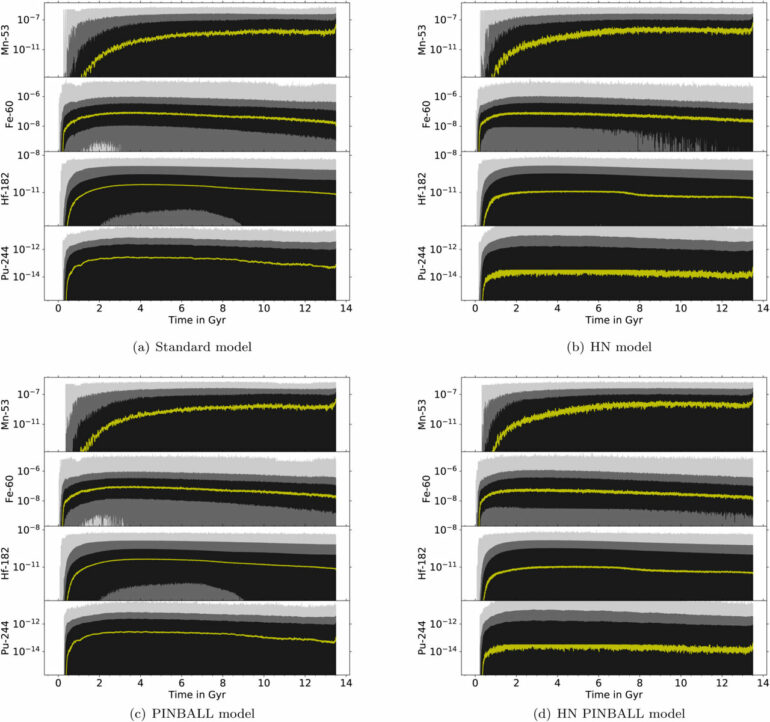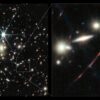Scientists researching the origin of elements in our galaxy have new insights into how they are transported to Earth, thanks to a new study led by authors at the University of Hertfordshire in the U.K. and the Konkoly Observatory, Research Center for Astronomy and Earth Sciences (CSFK) in Hungary.
As well as understanding how our planet became enriched with these elements, the results could also help scientists uncover which exoplanets outside our solar system are most likely to contain life.
Many elements around us were produced either through stellar explosions called supernovae, or violent collisions of extremely dense objects called neutron stars. One of the questions puzzling scientists was how these heavy elements then reach us here on Earth—and in particular, how elements that originate in different places seem to have reached our planet at the same time.
Using sophisticated computer modeling of the elements’ journey through space, scientists have now found that the heavy elements produced in collisions of neutron stars can “surf” on blast waves of other supernovae across our galaxy and down to Earth.
The mystery was first raised in 2021 when radioactive isotopes discovered inside deep-sea rocks revealed a surprise for the scientists studying their origin. The isotopes did not originate inside our solar system, but in explosions of stars elsewhere in the galaxy. Some of the detected isotopes especially raised eyebrows in the research community, because of their very different production sites.
Specifically, scientists found manganese-53 (associated with explosions of white dwarfs); iron-60 (produced in core-collapse supernovae); and plutonium-244 (which can usually only be produced by merging two extreme objects called neutron stars) sitting in layers of a similar depth in deep-sea rock samples.
To reach Earth, these isotopes would have rained down from the sky at some point during the last couple of million years. Since deep-sea sediments accumulate layer by layer over time to form rocks, researchers were very puzzled by the fact that these three isotopes, originating from different types of stellar explosions, were found in rock layers of similar depth. Finding them at similar depths means that they must have arrived on Earth together, even though their origin sites are so vastly different.
To understand how it was possible for these isotopes to arrive on Earth together, a team led by Dr. Benjamin Wehmeyer at the University of Hertfordshire in the U.K., and the CSFK in Hungary, used computer models to simulate how the isotopes travel from their Galactic production sites throughout space.
The study found that the ejected content of different astrophysical sites—from colliding neutron stars to exploding white dwarfs—are pushed around in the galaxy by the shock waves of the much more frequent core-collapse supernovae. These supernovae are explosions of the cores of massive stars, which are much more common than explosions triggered by the merging of two neutron stars or explosions of white dwarfs.
Dr. Wehmeyer and his team observed that after they are produced, the isotopes can then “surf” on the shockwaves of these supernovae. This means that isotopes produced in very different sites can end up traveling together on the edges of the shock waves of core-collapse supernova explosions. Some of this swept-up material ends up on Earth, which can explain why the isotopes were found together within similar layers of deep-sea rocks.
Lead author Dr. Wehmeyer explained, “Our colleagues have dug up rock samples from the ocean floor, dissolved them, put them in an accelerator, and examined the changes in their composition layer by layer. Using our computer models, we were able to interpret their data to find out how exactly atoms move throughout the galaxy.
“It’s a very important step forward, as it not only shows us how isotopes propagate through the galaxy, but also how they become abundant on exoplanets—that is, planets beyond our solar system. This is extremely exciting, since isotopic abundances are a strong factor in determining whether an exoplanet is able to hold liquid water—which is key to life. In the future, this might help to identify regions in our galaxy where we could find habitable exoplanets.”
Dr. Chiaki Kobayashi, Professor of Astrophysics at the University of Hertfordshire and co-author of the study, adds, “I have been working on the origins of stable elements in the periodic table for many years, but I am thrilled to achieve results on radioactive isotopes in this paper. Their abundance can be measured by gamma-ray telescopes in space as well as by digging the rocks underwater of the Earth.
“By comparing these measurements with Benjamin’s models, we can learn so much about how and where the composition of the solar system comes from.”
The work is published in The Astrophysical Journal.
More information:
Benjamin Wehmeyer et al, Inhomogeneous Enrichment of Radioactive Nuclei in the Galaxy: Deposition of Live 53Mn, 60Fe, 182Hf, and 244Pu into Deep-sea Archives. Surfing the Wave? The Astrophysical Journal (2023). DOI: 10.3847/1538-4357/acafec
Provided by
University of Hertfordshire
Citation:
Radioactive isotopes reach Earth by surfing supernova blast waves, scientists discover (2023, February 20)



